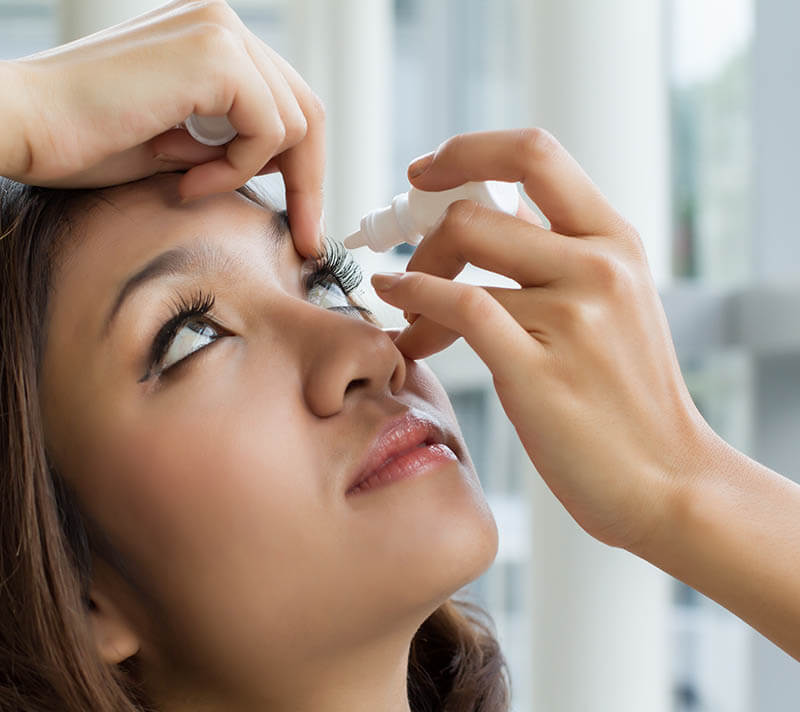Dry Eye Treatment
Dry eyes occur when your eyes are not producing enough lubricating tears. This can be a little confusing since one of the most common symptoms of dry eye syndrome is excessive watering of the eyes! How is this possible? The eye makes two different types of tears.
The first type, known as lubricating tears, contains a precise balance of water mucus, oil, nutrient proteins, and antibodies to nourish and protect the front surface of the eye. Lubricating tears are produced slowly and steadily throughout the day.
The second type of tear, called reflex tears, does not have much lubricating value. Reflex tears are exactly what the name suggests, they are an automatic reflex to flush the eye when it is suddenly irritated or injured. These tears gush out in such large quantities that the tear drainage system can’t handle them all and they spill out onto your cheek. Reflex tears might occur when you get something in your eye when you’re cutting onions, when you’re around smoke, or when you accidentally scratch your eye. With dry eye syndrome, the primary cause of reflex tearing is irritation of the eye from lack of lubricating tears.
In addition to continuous reflex tearing, many patients describe their symptoms as if they had a spec of sand in their eye. Itching and burning can occur. Vision can become blurry and the eyes can become red and produce a mucous discharge.

Dry eye syndrome often occurs as a part of the natural aging process. As we age, glands in the eyelid produce less oil which allows tears to evaporate too quickly. The oil keeps tears from evaporating off the eye, preventing the eye from becoming too dry.
There are roughly 30 million people in the United States and over 300 million worldwide who have been diagnosed with dry eye. Most have learned to live with eye discomfort and have become dependent on drops or other treatment methods that only offer temporary relief. This has been due to a lack of understanding that the root cause of most dry eye (86%) is now known to be a chronic and progressive condition, Meibomian Gland Dysfunction or MGD.
MGD occurs when there is a compromise to the function and/or structure of the meibomian glands in the eyelids that produce the protective oily layer of the tear film. These glands can become blocked over time and can no longer produce oils needed for healthy tears. This blockage results in rapid evaporation of your tears and can lead to irritation, discomfort, and if not treated, gland dropout.

Other causes of dry eye can include:
- Diseases such as diabetes, Sjogren’s, and Parkinson’s.
- Post-menopausal or other hormonal changes
- Prescription medications include some high blood pressure medications, antihistamines, diuretics, antidepressants, anti-anxiety pills, sleeping pills, and pain medications.
- Over-the-counter medications including some cold and allergy products, motion sickness remedies, and sleep aids.
- Hot dry or windy conditions
- High altitude, air-conditioning, and smoke
- Reading, using a computer, or watching TV
- Contact lenses
- Various types of eye surgery including LASIK
- Recent research suggests that dry eye may be caused by inflammation due to an imbalance of “good” fats and “bad” fats.
Measuring your rate of tear production and checking how long it takes for tears to evaporate in between blinks are two ways your eye doctor can check for dry eye. By using magnifying instruments, the doctor can also check for pinpoint scratches on the front surface of the eye caused by dryness using special, colored eyedrops called fluorescein or Rose Bengal.
Meibomian Gland Dysfunction Identification
A series of evaluations will be performed to determine if you have MGD. This can include a LipiView® tear film and gland imaging and a meibomian gland evaluation. Knowing what is causing your Dry Eye will help your doctor determine the best treatment option.
Now, with the breakthrough LipiFlow® technology, it’s possible to directly treat the root cause of MGD.
Treatment for Dry Eye Syndrome
Treating MGD with LipiFlow
While there are multiple choices available for treating MGD, LipiFlow is the only FDA-cleared device for removing gland blockages and restoring gland function. Through advances in the application of Vectored Thermal Pulsation (VTPTM) technology, the LipiFlow treatment utilizes a patented algorithm of heat applied to the inner eyelids and massage to remove the obstructions in your meibomian glands.
Serum Tears Treatment
Slade & Baker Vision began offering an exciting revolutionary new treatment for dry eye at our clinic.
Everyone’s dry eyes are different, from the severity to the cause! We can now create a customized treatment for you, from your own blood plasma.
Our Slade & Baker team has a phlebotomist on staff who joined our practice as our Dry Eye Specialist to help us create this treatment as an in-house offering to our patients.
*Please note that Serum Tears is not a new procedure. Data has supported this treatment for years and we are so proud to now offer it as a treatment for our patients. It is so convenient to be able to process this in-house for our patients with a dry eye specialist who can customize a dry eye plan for each individual patient!
Call us today at 713-626-5544 if you or a loved one suffers from dry eye symptoms, as this dry eye treatment may be just the right thing for you.
Artificial Teardrops
Artificial teardrops that help make up for the lack of natural lubricating tears are the most common way to treat dry eye. There are many different over-the-counter brands of artificial tears that come in liquid, or longer-lasting gel form (most often recommended for nighttime use). Some contain preservatives, some do not. Preservatives may cause irritation to those patients with sensitive eyes. In most cases, artificial tears can be used as often as needed although you should follow the regimen your doctor prescribed to you.
Punctal Occlusion
Punctal occlusion is a medical treatment for dry eye that may enable your eyes to more efficiently use the limited lubricating tears they produce. During this treatment, your doctor will insert a small plug (called a “punctal plug”) in one or more puncta to slow the drainage of tears from your eyes.
By slowing the rate of your tear drainage, more tears stay on your eyes and relieve your dry eye symptoms. This is a simple, in-office treatment that is performed in seconds and the doctors at Slade & Baker Vision Center can do this during your exam at our office.
Lid Cleansing / Antibiotics
Special lid cleansing techniques or antibiotics may be recommended when infection, inflammation of the eyelids or clogged oil glands contribute to dry eye. Patients may also be advised to avoid hot, dry, or windy environments or to humidify the air in their home or office.
Restasis®
A new and exciting treatment for dry eye disease is Restasis. Restasis is a product that reduces inflammation by helping the eye produce more tears. Restasis is the first drug proven to not only temporarily alleviate the symptoms of dry eye, but to effectively treat the cause.
If you have questions about Dry Eye, please do not ever hesitate to call our office at 713-626-5544 and speak to our experts and schedule a consultation today!

The doctors at Slade and Baker Vision have either authored or reviewed and approved this content.





